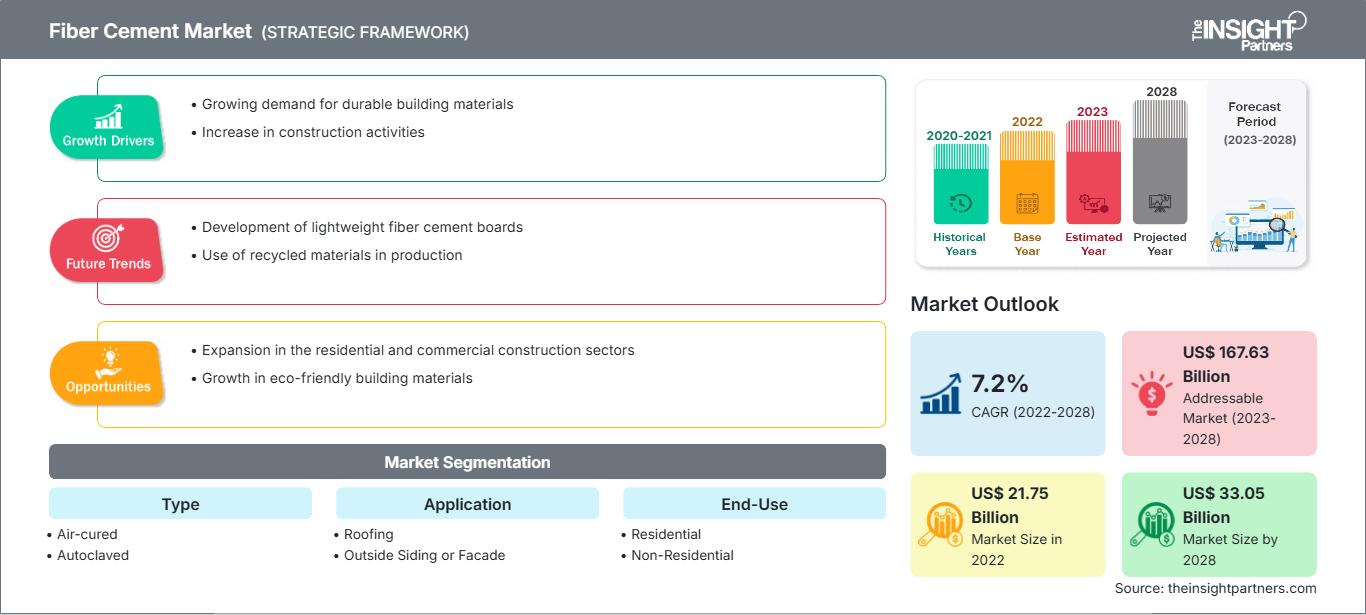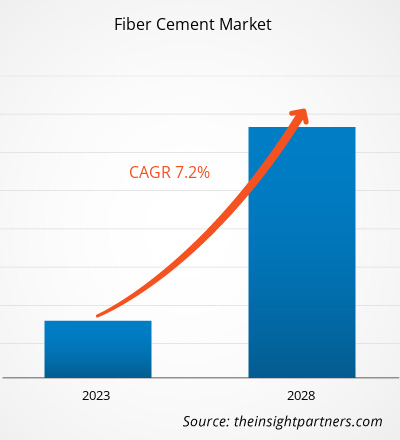[Informe de investigación] Se prevé que el tamaño del mercado del fibrocemento crezca de 21.748,45 millones de dólares estadounidenses en 2022 a 33.052,23 millones de dólares estadounidenses en 2028; se estima que registrará una tasa de crecimiento anual compuesta (TCAC) del 7,2% entre 2022 y 2028.
El fibrocemento se utiliza comúnmente como revestimiento exterior debido a su excelente durabilidad y resistencia a la intemperie y al fuego. Además, se emplea con frecuencia como material para techos por su capacidad para soportar condiciones climáticas adversas, como lluvias intensas, granizo y viento. Asimismo, el fibrocemento puede utilizarse para molduras y fachadas, ya que es fácil de moldear y se puede pintar o teñir para que combine con el exterior del edificio. También se usa frecuentemente en edificios comerciales, como hospitales, escuelas y oficinas, ya que ofrece una opción duradera y de bajo mantenimiento para sus exteriores.
En 2022, Asia Pacífico ostentó la mayor cuota de ingresos del mercado mundial del fibrocemento. La demanda de fibrocemento está aumentando en Asia Pacífico debido a la creciente concienciación sobre sus beneficios. Esta región se ha consolidado como uno de los mercados más importantes para la utilización de placas de fibrocemento gracias al auge de la actividad constructiva. Además, iniciativas y políticas gubernamentales como «Make in India» fomentan la instalación de diversas plantas de fabricación en la India. El aumento de la inversión extranjera directa también impulsa el crecimiento económico en la región. Se prevé que el creciente uso de placas de fibrocemento en numerosos sectores residenciales y no residenciales incremente la demanda de este material en Asia Pacífico en los próximos años. En la India, la industria de la construcción es la segunda más importante después de la agricultura, y representa aproximadamente el 11 % del PIB del país. El sector de la construcción contribuye significativamente al crecimiento del mercado.
Obtendrá personalización gratuita de cualquier informe, incluyendo partes de este informe, análisis a nivel de país y paquetes de datos de Excel. Además, podrá aprovechar excelentes ofertas y descuentos para empresas emergentes y universidades.
Mercado del fibrocemento: Perspectivas estratégicas

-
Obtenga las principales tendencias clave del mercado que se describen en este informe.Esta muestra GRATUITA incluirá análisis de datos, que abarcarán desde tendencias de mercado hasta estimaciones y pronósticos.
Impacto de la pandemia de COVID-19 en el mercado del fibrocemento
El sector de la construcción ha sido el principal impulsor de la demanda de fibrocemento. La pandemia de COVID-19 afectó negativamente el crecimiento del sector químico y de materiales, así como el mercado del fibrocemento. La implementación de medidas para combatir la propagación del SARS-CoV-2 impactó negativamente el crecimiento de diversas industrias. Sectores como el del embalaje, bienes de consumo, automoción y transporte, textil y construcción se vieron perjudicados por las interrupciones en la eficiencia operativa y las cadenas de valor debido al cierre repentino de las fronteras nacionales e internacionales. Durante la pandemia de COVID-19, la caída de los ingresos y el aumento de las dificultades en la ejecución de proyectos provocaron la contracción del sector en la mayoría de los mercados, con el consiguiente impacto negativo en la mano de obra. Las constructoras experimentaron retrasos y un aumento de los costes de las materias primas importadas y los materiales de construcción prefabricados debido al cierre prolongado de muchas fábricas. Los daños sufridos por el sector de la construcción frenaron la demanda de fibrocemento durante la pandemia.
Perspectivas del mercado
El aumento de la demanda de edificios energéticamente eficientes impulsa el crecimiento del mercado del fibrocemento.
Según el Programa de Asistencia para la Gestión del Sector Energético, casi un tercio de la energía mundial se consume en edificios residenciales, públicos y comerciales para climatización (calefacción, ventilación, cocina, refrigeración), iluminación, calentamiento de agua y funcionamiento de dispositivos eléctricos y mecánicos. La modernización de las ciudades en los países en desarrollo y el aumento de la renta per cápita impulsan el consumo de energía en los edificios de todo el mundo. El elevado consumo energético en edificios públicos, residenciales y comerciales genera la necesidad de ahorrar energía. Según la Agencia Internacional de la Energía, se prevé que los edificios representen aproximadamente el 41 % del potencial de ahorro energético mundial para 2035, mientras que los sectores industrial y de transporte aportarán el 24 % y el 21 %, respectivamente. Se aplica una capa de fibrocemento al edificio para reducir la transferencia de calor a través de las paredes, manteniendo el interior más cálido en invierno y más fresco en verano, lo que contribuye a reducir el consumo de energía. Según el Manual de Fundamentos de ASHRAE, el fibrocemento tiene un valor R de 0,15, superior al del ladrillo y la piedra.
Información sobre tipos
Según su tipo, el mercado global de fibrocemento se divide en fibrocemento curado al aire y fibrocemento curado en autoclave. El segmento de fibrocemento curado en autoclave ostentó una mayor cuota de mercado en 2022. Este tipo de fibrocemento se elabora con una mezcla de cemento, arena, fibras de celulosa y otros aditivos. La mezcla se moldea en láminas o placas y luego se cura en un autoclave, un recipiente a alta presión que aplica calor y vapor al material. El proceso de curado en autoclave provoca una reacción química que fortalece el material, haciéndolo más duradero y resistente al agua, al fuego y a las plagas. Se utiliza generalmente en una amplia gama de aplicaciones, como techos, revestimientos, suelos y como base para baldosas cerámicas. Además, el fibrocemento curado en autoclave también destaca por su versatilidad y flexibilidad de diseño, ya que puede imitar la apariencia de otros materiales de construcción, como la madera o la piedra. Asimismo, está disponible en diversos colores y texturas, lo que lo convierte en una opción popular tanto para proyectos de construcción residenciales como comerciales.
James Hardie Industries plc, Etex NV, Swisspearl Group AG, CSR Ltd, NICHIHA Corp, Plycem Construsistemas Costa Rica SA, Compagnie de Saint Gobain SA, Century Plyboards Ltd, Everest Industries Ltd e Isam Khairi Kabbani Group son algunos de los principales actores que operan en el mercado mundial del fibrocemento. Estos actores se centran en ofrecer productos de alta calidad para satisfacer la demanda de los clientes y están adoptando estrategias como la inversión en investigación y desarrollo y el lanzamiento de nuevos productos.
Reportajes destacados
- Tendencias progresivas de la industria en el mercado del fibrocemento para ayudar a los participantes a desarrollar estrategias efectivas a largo plazo.
- Estrategias de crecimiento empresarial adoptadas por los mercados desarrollados y en desarrollo
- Análisis cuantitativo del mercado del fibrocemento de 2020 a 2028
- Estimación de la demanda mundial de fibrocemento
- Análisis de las cinco fuerzas de Porter para ilustrar la eficacia de compradores y proveedores que operan en la industria
- Desarrollos recientes para comprender el panorama del mercado competitivo
- Tendencias y perspectivas del mercado, así como factores que impulsan y restringen el crecimiento del mercado del fibrocemento
- Asistencia en el proceso de toma de decisiones mediante el análisis de estrategias de mercado que sustentan el interés comercial, lo que conduce al crecimiento del mercado.
- Tamaño del mercado del fibrocemento en diversos nodos
- Descripción general detallada y segmentación del mercado, así como la dinámica de la industria del fibrocemento.
- Tamaño del mercado del fibrocemento en diversas regiones con prometedoras oportunidades de crecimiento
Perspectivas regionales del mercado del fibrocemento
Los analistas de The Insight Partners han explicado en detalle las tendencias y los factores regionales que influyen en el mercado del fibrocemento durante el período de previsión. Esta sección también analiza los segmentos del mercado del fibrocemento y su distribución geográfica en Norteamérica, Europa, Asia Pacífico, Oriente Medio y África, y Sudamérica y Centroamérica.
Alcance del informe de mercado del fibrocemento
| Atributo del informe | Detalles |
|---|---|
| Tamaño del mercado en 2022 | 21.750 millones de dólares |
| Tamaño del mercado para 2028 | 33.050 millones de dólares estadounidenses |
| Tasa de crecimiento anual compuesto global (2022 - 2028) | 7,2% |
| Datos históricos | 2020-2021 |
| Período de pronóstico | 2023-2028 |
| Segmentos cubiertos |
Por tipo
|
| Regiones y países cubiertos |
América del norte
|
| Líderes del mercado y perfiles de empresas clave |
|
Densidad de los actores del mercado del fibrocemento: comprensión de su impacto en la dinámica empresarial
El mercado del fibrocemento está creciendo rápidamente, impulsado por la creciente demanda de los usuarios finales debido a factores como la evolución de las preferencias de los consumidores, los avances tecnológicos y una mayor conciencia de los beneficios del producto. A medida que aumenta la demanda, las empresas amplían su oferta, innovan para satisfacer las necesidades de los consumidores y aprovechan las nuevas tendencias, lo que impulsa aún más el crecimiento del mercado.

- Obtenga una visión general de los principales actores del mercado del fibrocemento.
Mercado mundial de fibrocemento
Según el tipo de fibra, el mercado mundial del fibrocemento se segmenta en función del tipo, la aplicación y el uso final. Según el tipo, se divide en fibrocemento de curado al aire y fibrocemento curado en autoclave. Según la aplicación, se segmenta en techos, revestimientos exteriores o fachadas y otros. Según el uso final, se divide en residencial y no residencial.
Perfiles de empresas
- James Hardie Industries plc
- Etex NV
- Grupo Swisspearl AG
- CSR Ltd
- NICHIHA Corp
- Plycem Construsistemas Costa Rica SA
- Compagnie de Saint Gobain SA
- Century Plyboards Ltd
- Everest Industries Ltd
- Grupo Isam Khairi Kabbani
- Análisis histórico (2 años), año base, pronóstico (7 años) con CAGR
- Análisis PEST y FODA
- Tamaño del mercado, valor/volumen: global, regional y nacional
- Industria y panorama competitivo
- Conjunto de datos de Excel
Informes recientes
Informes relacionados
Testimonios
Razón para comprar
- Toma de decisiones informada
- Comprensión de la dinámica del mercado
- Análisis competitivo
- Información sobre clientes
- Pronósticos del mercado
- Mitigación de riesgos
- Planificación estratégica
- Justificación de la inversión
- Identificación de mercados emergentes
- Mejora de las estrategias de marketing
- Impulso de la eficiencia operativa
- Alineación con las tendencias regulatorias






















 Obtenga una muestra gratuita para - Mercado de fibrocemento
Obtenga una muestra gratuita para - Mercado de fibrocemento